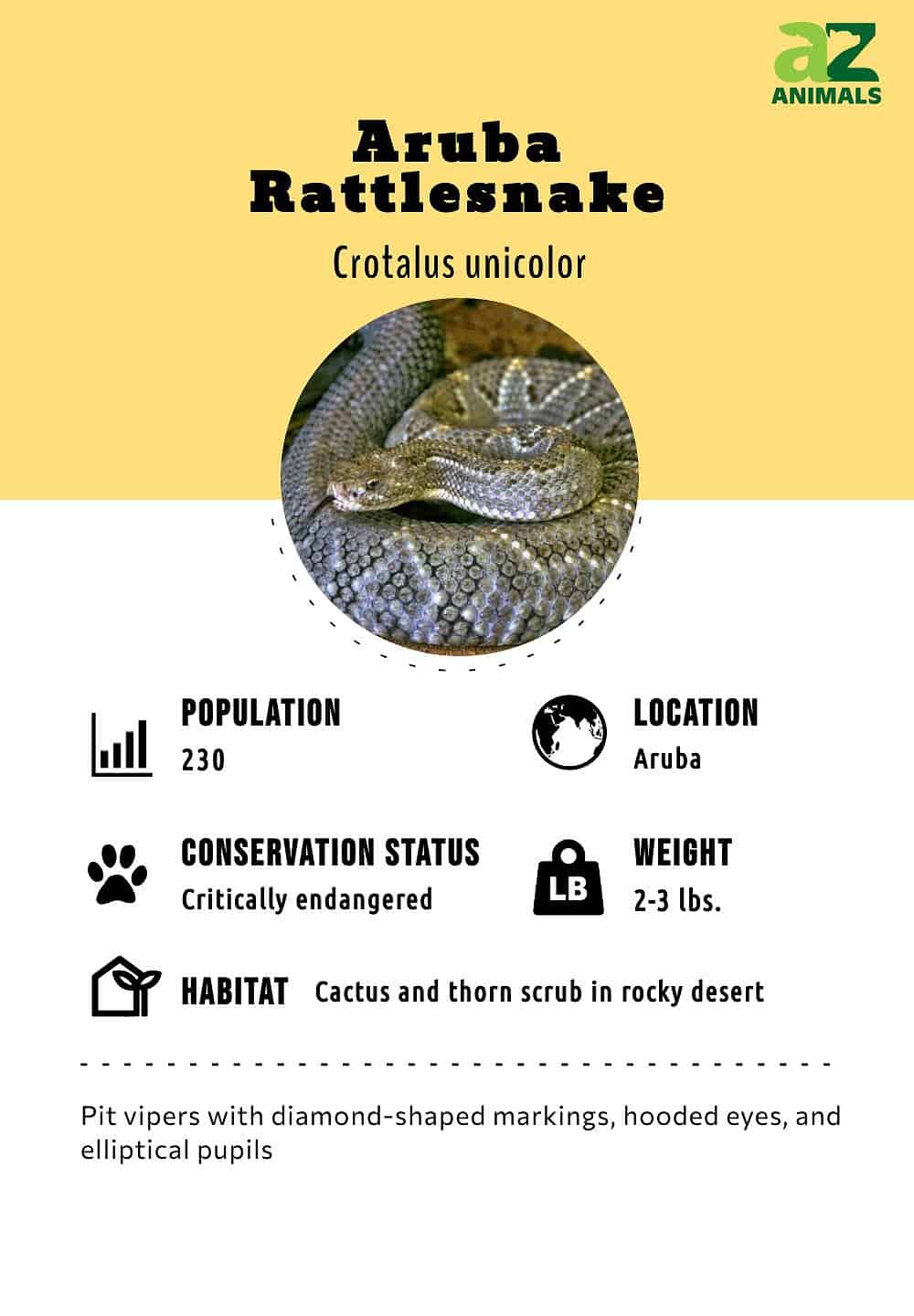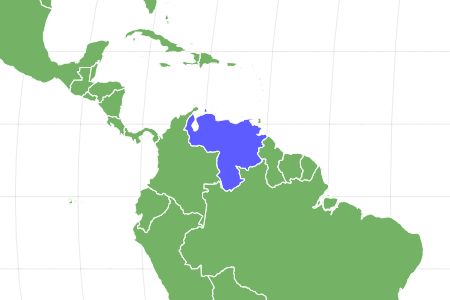Aruba Rattlesnake
Crotalus unicolor
This rattlesnake only lives on the island of Aruba.
Advertisement
Aruba Rattlesnake Scientific Classification
- Kingdom
- Animalia
- Phylum
- Chordata
- Class
- Reptilia
- Order
- Squamata
- Family
- Viperidae
- Genus
- Crotalus
- Scientific Name
- Crotalus unicolor
Read our Complete Guide to Classification of Animals.
Aruba Rattlesnake Conservation Status
Aruba Rattlesnake Facts
- Prey
- small rodents, birds, and lizards
- Name Of Young
- Neonates
- Fun Fact
- This rattlesnake only lives on the island of Aruba.
- Estimated Population Size
- Unknown
- Biggest Threat
- Human encroachment
- Gestation Period
- About four months
- Temperament
- Mild-mannered
- Litter Size
- 5-15
- Habitat
- Dry, rocky areas on the island
- Diet
- Carnivore
- Lifestyle
- Nocturnal/Crepuscular
- Location
- Aruba
Aruba Rattlesnake Physical Characteristics
- Color
- Brown
- Grey
- Fawn
- Skin Type
- Scales
- Length
- 2-3 feet
- Venomous
- Yes
- Aggression
- Low
View all of the Aruba Rattlesnake images!
The Aruba rattlesnake is a highly venomous pit viper that lives only on the island of Aruba.

This small rattlesnake feeds on various small animals like rodents, lizards, and birds. It is critically endangered and the subject of conservation efforts to save the species.
3 Amazing Facts
- The Aruba rattlesnake is the rarest of all rattlesnakes. There may only be 230 left in the world; about half of those are in captive-breeding programs.
- Females breed only about every two years and give birth to several fully-developed young.
- Their markings resemble that of the Eastern diamondback rattlesnake, only very faded.
Scientific Name

The scientific name of the Aruba rattlesnake is
Crotalus unicolor, i.e., crotalus meaning rattle and unicolor meaning one color.
©iStock.com/Ondrej Prosicky
The Aruba rattlesnake is a pit viper in the Viperidae subfamily of Crotalinae, which contains all but three rattlesnake species. Depending on how you count them, there are between 30 and 60 rattlesnake species. Whether to grant a snake full species status or count it as a subspecies of another is an ongoing discussion. As scientists do more genetic research, more animals’ species names and species statuses change to reflect that research.
The scientific name of the Aruba rattlesnake is Crotalus unicolor. Some scientists believe it isn’t different enough to give it full species status and consider it a subspecies of the tropical rattlesnake (Crotalus durissus). In that case, the scientific name is Crotalus durissus unicolor.
Crotalus originates in Greek and means rattle, and unicolor means one color. Locally known as the cascabel, the Aruba rattlesnake is the only venomous snake species on the island.
Appearance and Description
This species is on the smaller side for rattlers, so adults generally measure between two and three feet long. Aruba rattlesnakes can be blue-gray, light tan, peach, or even yellowish, depending upon where on the island the individual lives.
Since these are rattlesnakes, they have rattles composed of loosely interlocking scales made of keratin and the typical spade-shaped head of pit vipers. They often have darker markings on their heads, with stripes that start behind the eyes and travel toward the back. There are also faint diamonds down the length of their backs. Like other pit vipers, this species has hooded eyes, which are difficult to see when viewed from above. They also have elliptical pupils and heat-sensing organs located between their eyes and nostrils.
Aruba rattlesnakes have long fangs attached to venom glands; these fangs fold up into their mouths when they don’t need them. Rattlesnakes have what might be the most advanced venom delivery system in nature and can inject venom very deeply into their prey (or their victim).
Behavior and Humans

The Aruba rattlesnake lives mostly on the island’s interior, staying away from humans living on the coastline.
©reptiles4all/Shutterstock.com
Aruba rattlesnakes aren’t aggressive and only bite when provoked. Most of their territory is in the island’s interior, and most people live on the coast. However, given the Island’s small size and that the snakes inhabit the southeastern half of the island, encounters are inevitable.
In the Arikok National Park, rangers help monitor the Aruba rattlesnake population by capturing, tagging/documenting, and releasing individual snakes. They gather information about each rattlesnake’s movement, breeding, and overall health. The monitoring program helps researchers and conservationists understand how expanding human settlements and introduced species, such as the boa constrictor, affect this rare rattlesnake species.
This snake has been captive-bred by zoos around the world for over 60 years in an attempt to preserve the species. While the zoos have been somewhat successful, the island’s human population continues to grow and further reduce suitable living areas for the Aruba Island rattlesnake.
Location
This species lives in just one place: Aruba. It’s an island off the coast of Venezuela that is home to several endemic species, including the Aruba leaf-tailed gecko and Aruba whiptail. Aruba rattlesnakes inhabit the southeastern half of the island in rocky desert habitats. As ambush predators, these snakes prefer the cover of cactus and thorn scrub where they hide and wait for their prey.
Aruba rattlesnakes are nocturnal during the hot summer months and become active during the morning and evening hours when the nights are cooler. Like all snakes, they eat a variety of smaller animals; however, this species’ primary food source is the Aruba whiptail, a lizard endemic to the island of Aruba.
They prefer habitats away from human activity. You’re more likely to find an Aruba rattlesnake in the rocky hills than in the city. These snakes don’t wander far during their lifetime, and many stay within a range of 1-2 square miles.
Population and Conservation Status
It’s a rare species, and the Association of Zoos and Aquariums has a species survival plan to preserve the species via captive breeding programs. The IUCN included them on the Redlist until 2021 but they haven’t reassessed the species yet. However, population estimates show that the Aruba rattlesnake is critically endangered, with as few as 230 snakes left in the wild.
The Aruba Island rattlesnake is rare, one of the rarest in the world. The first captive breeding success was at the San Diego Zoo in 1948; others have since followed suit, including the first UK captive-bred Aruba rattlesnakes born in 1997. At this point, the most significant threats they face are human encroachment due to the growing population on the island and illegal poaching for the pet trade.
That’s not to say those are their only threats. Also of concern is the boa constrictor. This species was first sighted on the island in 1999. Conservationists are concerned because it shifts the balance any time you introduce a new species to an environment. As recently as 2021, researchers believe that the boa population is stable. However, they’re not sure how, or even if, it has negatively affected the native Aruba rattlesnake.
Venom
There aren’t many documented envenomations by the Aruba Island rattlesnake. However, the few that have been treated in recent history used antivenom made from the Tropical rattlesnake (C. durissus). One victim was bitten by the snake he kept as a pet.
Aruba Rattlesnake venom resembles the tropical rattlesnake inhabiting a vast South American territory. It’s a combination of hemotoxins and neurotoxins that helps the species digest its food. Unfortunately, it also breaks down the tissue of anything they bite, including humans.
This island-dwelling species isn’t aggressive, and even its rattle gives you a chance to back away before it bites. Like all rattlesnakes, they have hinged fangs that operate like hypodermic needles and can inject a large amount of venom with one bite. That said, these snakes often deliver “dry bites,” where they don’t inject venom, but if you’re bitten, seek emergency medical care immediately.
Similar Animals
View all 194 animals that start with AAruba Rattlesnake FAQs (Frequently Asked Questions)
Are Aruba rattlesnakes venomous?
Yes, and like other vipers, they sport an extremely advanced venom-delivery system. Only about one-seventh of venomous snakes have hollow fangs.
What do Aruba rattlesnakes eat?
Like most snakes, they’re obligate carnivores. They must have raw meat in order to survive, and they eat lizards, birds, and rodents.
Why aren't they listed on the IUCN Redlist?
They were until 2021. However, the IUCN doesn’t have enough recent data to determine whether they should again be included.
How do Aruba Rattlesnakes hunt?
Primarily, they’re ambush predators. However, they’ll occasionally chase down their prey.
Thank you for reading! Have some feedback for us? Contact the AZ Animals editorial team.
Sources
- Kauffeld, Carl F., and Howard K. Gloyd. “Notes on the Aruba Rattlesnake, Crotalus Unicolor.” Herpetologica, vol. 1, no. 6, [Herpetologists’ League, Allen Press], 1939, pp. 156–60, http://www.jstor.org/stable/3890132. / Published March 30, 1939 / Accessed March 29, 2022
- Aruba Rattlesnake Bite | DovMed / Published March 24, 2019 / Accessed March 29, 2022
- Central Florida Zoo & Botanical Garden / Accessed March 29, 2022
- Kauffeld, Carl F., and Howard K. Gloyd. “Notes on the Aruba Rattlesnake, Crotalus Unicolor.” Herpetologica, vol. 1, no. 6, [Herpetologists’ League, Allen Press], 1939, pp. 156–60, http://www.jstor.org/stable/3890132. / Published March 30, 1939 / Accessed April 1, 2022


















